
Up now in the Mt. Airy Contemporary Artists Space (MACAS), the works of John Darling-Wolf and Abigail Patterson present inquiries into scale and form that leave one’s sense of proportion in suspense. Curator Andrea Keefe’s choice to pair these artists together was based on a feeling that the artists’ connections to one another go beyond their obvious affinity for off-kilter geometric constructs. Darling-Wolf’s and Patterson’s works complement one another on a number of levels, with the physical presence of Patterson’s drawings, some of which possess a metallic patina caused by the dense application of graphite over collages on paper, both harmonizing and juxtaposing with Darling-Wolf’s sheet-metal and bent-wire sculptures and other works on paper.
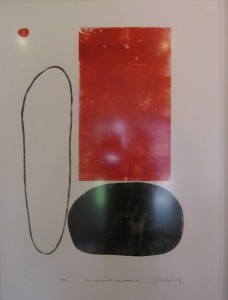
Darling-Wolf, an architect as well as sculptor and printmaker, likes to play with impermanence and uncertainty — odd qualities for an architect responsible for the structural integrity of buildings. His pieces in the show include collographs, and the folded metal sheets used to print them, along with densely complex 3×3 inch watercolors, free-standing bent-wire sculptures, and prints — all of which draw nourishment from play with the elasticity of lines, the solidity of colors, and the alternating concepts of lightness and weight.
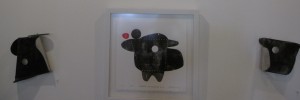
Darling-Wolf’s “tag sculptures,” as he calls them, are arranged in various configurations around the gallery. Some of the finished products, or “cerebral tag sculptures,” stand beside the printing sheets, or “aluminum tag sculptures,” used to make them, which are stained black from printing ink (see above). The one-to-one relation between printing object and product is both an exposure of the artist’s process, and also an arrangement that highlights the mutual necessity of both components in the designs that Darling-Wolf is exploring. The two views of the same object feel like two different sense perceptions of one concept, akin to the natural separation of seeing and hearing or tasting and touching. In both versions, a lone, organic, anima-imbued creature stands, either two-dimensionally or three-dimensionally, showing the way an entity stands or falls in its separate forms.
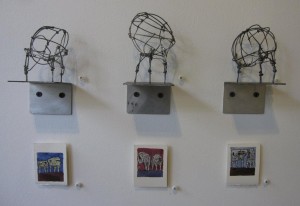
Bottom, from left to right: “Woven Forms Blue/Violet”; “Woven Forms Burgundy”; “Woven Forms Light Blue/Violet”, watercolor and ink on Rives BFK
In the arrangement of Darling-Wolf’s galvanized wire sculpture and watercolor “Woven Forms” (above), the one-to-one presentation of pieces again leads the eye on a thrilling back-and forth between the flat, detailed, obsessively intertwined watercolors and the simpler but similarly posed wire sculptures above them. By placing their subjects in scale with far smaller forms, the tiny watercolors suggest an illusory vanishing point that creates a telescoping effect. Above, the wire sculptures in comparison appear massive, perhaps as large as buildings in the free-floating uncertainty of scale Darling-Wolf has conveyed.
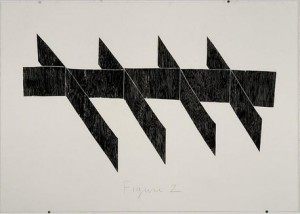
Abigail Patterson’s works on paper similarly distort space, evoking familiar geometric constructs that avoid the literal through the use of freehand strokes, allowing these forms to wiggle somewhat. “Untitled (Figure 2),” (above), depicts a series of long, intersecting rectangles that somewhat resemble the inner structure of a cardboard box. This surprising familiarity lends a touch of whimsy to the otherwise stark and ominous creation, as does the slight curve to the outer lines. But lines that from a distance seem orderly are up close shown to be unruly and chaotic. The design, which tricks the eye into seeing few shapes from afar, on closer inspection appears far more fragmented, as the various segments of the collage are revealed to be discrete quadrangles made even more disorienting by their wood-grain texture.
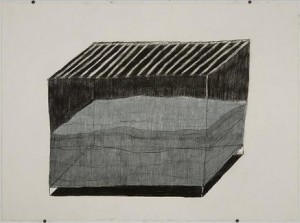
The initial impression given by Patterson’s “Water Study II” is a solid black and grey mass that seems to contain a topographical cross section of a larger, more expansive whole. Is it a body of water beneath the grate of a sewer, a cross-section of the ocean on display, or something else entirely, solidified into wave-like shapes? The organic and fluid nature of these lines contained within this crooked cube also seems somewhat comical, balanced precariously on spindly little legs. Like many pieces in the show, this cube-like form simultaneously floats weightlessly on the page and is an object of immense solidity and weight, distorting our sense scale and proportion. Whatever guideposts may establish meaning in this piece are modified by the deceptive planar structure of the shape into something amorphous, leaving room for the viewer’s own narrative.
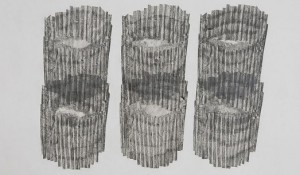
Both artists’ works in this show imbue what at first seem like orderly and complete shapes with playful irony and depth. In Patterson’s drawings and collages, an illusory, flat picture plane undermines its orderly images with playful compositions. Darling-Wolf’s prints with metal plates present a solidity of shape that is utterly contradicted by the exposure of metal as a malleable tool in the artist’s woven-steel and folded metal sculptures. In the space between these artists’ works is space enough for countless re-imaginings of these figures to sail through, or for nothing at all.
The works of John Darling-Wolf and Abigail Patterson will be up at Mt. Airy Contemporary Arts Space through June 8. The gallery will be open Friday, May 31st, from 6 to 8 p.m.





